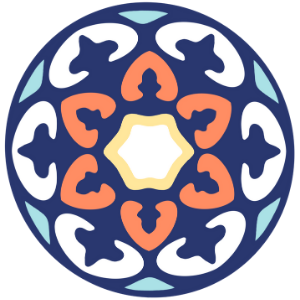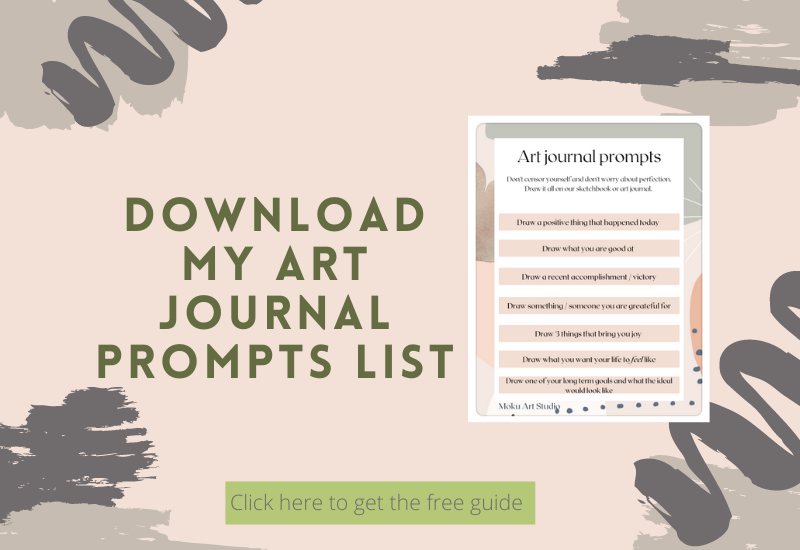Connect with your inner self through Art Journaling
Sitting in front of a blank paper, or choosing colors for a coloring book can be intimidating. What if it doesn’t look right? What if I don’t like it? Making art can sometimes seem scary and daunting. However, art can enrich your life and bring many positive changes.
Having a creative activity in your life feeds your soul and your brain. It makes us feel good, gives us “permission” to explore our feelings, build confidence and self-esteem and increase empathy.
In short, making art is good for you because:
It helps you visualize a positive future
It helps your focus
It lowers stress
It helps you process your emotions and feelings
It gives you a sense of achievement
One of the easiest ways of incorporating an art practice into your daily life is to keep an art journal.
What is a sketchbook?
A sketchbook is, usually, a blank notebook where artists can practice and jot down ideas. Traditionally, sketchbooks have been physical but many artists also keep digital sketchbooks.
Sketchbooks come in different sizes, paper types and colors. What if I don’t have a sketchbook?! This is why I love having an art journal, you can use anything you have, even a composition notebook or an old recycled book you can paint on.
When picking a sketchbook, pick the one that is right for you! it is really easy to be swayed into getting the “nicest” sketchbook but none of that matters. Think of what will work for you and make you happy. Think of the following:
The size you feel comfortable working in. Big? Small?
Would you like it to be portable? Be able to take it places with you? On a trip?
Do you like dry media? mixed media? Would you rather keep your options open?
How thick do you want it to be?
Paper weight does not always reflect quality but it is good to know what the weight of a paper can carry or its intended use. For example:
Watercolor 90-140 lbs
Drawing 70-80 lbs
Mixed media is usually around 90 lbs
“Art is just a container you pour yourself into”
Sketchbooks are really personal objects. They can contain daily rituals, personal experiences, ideas for inspiration, technical practice, art journaling, among other things. The relationship an artist has with their sketchbook can be different from person to person but they all provide a window into the artist’s mind.
How to use your sketchbook and start art journaling
Sketchbooks can be used in several ways. I will walk you through all the options and then give you a quick guide on how you can start your own art journaling practice. Having a sketchbook is all about the process and the discovery that happens on the page.
Play around
Sketchbooks are great places to just play around with new materials, get reacquainted with old materials, mix and match mediums and see where it takes you. Did you make a drawing on a napkin while waiting for your coffee? Add it to your sketchbook!
A sketchbook is a great way to start creating, specially if you don’t feel ready for more “formal” art practices. However! sketchbooks can be stand-alone pieces of art. I used to be very stuck with the idea of having to create “proper” art. Now, I look forward to when I have some time to sit and play with my sketchbook and have fun.
If you like keeping scraps of paper because you never know when they might come in handy (wink wink), your sketchbook is the perfect place for them! Add your scraps of paper, lettering, magazine cuttings, notes, gift tags, cards, etc., to your sketchbook and create art pages or mixed media pages. These can also serve as inspiration pages or keepsake pages.
The more you practice and work in your sketchbook, the more your creative confidence will grow.
Develop your ideas and skills
Keeping a sketchbook is a good way to develop your ideas, write down any important information, observations, making mind-maps, quick sketches, test out compositions and paint palette templates. It can work as your art kitchen!
If you have particular art skills you want to develop, a sketchbook is a great place to practice them. For example, you want to learn how to use your sketching pencils.
The first step would be to create and shade a value scale. For this type of exercise, you would use your darkest shading pencil, like 6B. Practicing with the darkest shading pencil will translate over to all your other pencils.
Then, once you have practiced your pencil pressure and shading, you can practice turning a circle into a sphere. You can add a cube, a pyramid and a prism.
Next, you can practice different ways to add value, such as hatching and crosshatching.
Finally, you decide that will use your newly hones shading skills to make a self-portrait just using your shading pencils.
Documenting your emotions, thoughts, ideas and travels
Use your sketchbook as documentation for all ideas, regardless of whether you think they are good or bad. You can also go back to those ideas at a later time.
Having a place for all your ideas makes it easier to organize them and your thoughts. An art journal is a great way to process your thoughts, ideas, and emotions. It can act as a safe space for regulation and expression. Having an art practice can help you learn how to manage your mental and emotional well-being in a positive way and help reduce stress and anxiety.
Keep all your art journals in a place where you can look back at them, or even flip back to the first pages you created. It is hard for us to notice how much we improve, but once we have a little bit of separation, you can see how our process has changed, how you start finding your art style, how your skills improved, and how far you’ve come.
A fun and exciting way to use documentation in your art journal is to use it as a travel art journal. When you go to a new place, on a journey, weekend trip, a long vacation or revisiting a known place, take your sketchbook with you!
You can make quick drawings on the places and details around you, like the architecture, important sites, the food you are and drank, notes on things that happened on the trip and full page compositions. I would recommend having a go-to pack with some sketching pencils, a pen, some markers and even travel watercolors.
Your travel art journal will work as a way to document and preserve your thoughts, memories and journeys for future reference. You can also create pages for treasured memories, persons and places. Revisiting these pages can spark ideas, recharge your creativity and help you be consistent with your art journaling practice.
When I was in college, I was not sure what I wanted to major in but knew that I had always enjoyed making art. I signed up for my first class and just fell head over heels. It took the pandemic to look at how I approached my own art practice and decide that it needed a reboot. I felt like I couldn’t make “proper art” during the pandemic so I started just making art for fun.
Although I have always used art-making in a therapeutic way, I noticed that making a conscious decision to have no expectations of what I was creating was benefiting my mental health. I noticed an increase in my creativity and ideas and a decrease in my anxiety and fear.
You may feel like you have little or limited creativity. But creativity can flourish at any age and time in our lives if we step outside our comfort zone, practice our newly acquired artistic skills in an exciting way, and stay present in the moment. Practice and consistency are the keys to training our brains to be more creative. So come practice with me!
An art journal is a visual diary that is open-ended, can incorporate writing, collage, paint (any medium really) where the process is more important than the end product. It is an excellent way to practice self-expression and self-care.
My goal is to help you explore your creativity regardless of your skill level or experience. I give you a list of prompts to get you started, but what I really want for you is to create your own! The idea behind this course is to help you take the first step and see you flourish in your own creativity, whatever form it takes on the page
“Art Journaling” is an online course that will teach you how to start an art journaling practice and give you food for your soul and brain! This is the first step in kickstarting your creativity, connecting with your inner artist, and allowing space for creative, logical, and emotional expression.
In this self-paced online course, you will be guided through the following areas:
How to properly take care of your brushes so they survive for a long time
Learn how to mix paint with only 3 colors so you can make all the colors you want
How colors relate to each other (and make browns on purpose)
How to pre-plan your pages so that you can create whenever you have the time
A prompt list to help you get started and overcome the fear of a blank page
How to use homemade supplies if you are not ready to buy art supplies
So, what exactly can you expect from this course?
The Art Journaling e-course will have 12 main sections with a mix of videos, pictures, and text.
As Picasso said, “Inspiration exists, but it has to find you working.” Artists have this reputation of being naturally creative and inspired. But what most people don’t see is all the hard work behind that final art piece. It requires daily work, practice, and diligence. You will create a thousand drawings or ideas that are terrible before you find one good one. The key is to start with that first one.
If you are ready to take the next step, come join me in my Art Journaling Course!
It is never too late to start your creative journey
If you are second-guessing yourself or if starting an art journaling practice seems scary, take a deep breath. It is never too late to start something new.
Did you know that the brain is an organ that is constantly learning and adapting to our environment and the activities we do? When we practice a particular skill consistently, we are changing our brain structure because we are feeding it a new and challenging task. Being creative and artistic is good for the soul AND the brain.
There is a great article by Artnet and Artsy on artists that got their break later in life:
Vincent Van Gogh went to art school at 27 for a short time, was mostly self-taught, and never sold a painting in his lifetime.
Edward Hopper sold his first painting at 31.
Frida Kahlo was a self-taught artist, there was a news article in 1933 that was titled “Wife of the master mural painter dabbles in work of art.” By this time in her life, she was already an artist in her own right. She was 47 when she had her solo exhibition in Mexico.
Anna Mary Robertson “Grandma” Moses was discovered at age 78 and was a self-taught painter.
Carmen Herrera sold her first painting at age 89.
Willem de Kooning had his first solo show at age 44.
Jerry Saltz was a long haul truck driver until the age of 41 and then he decided to become an art critic and became a Pulitzer prize-winning writer.
It is never too late to start something new or jump into your passion.


















